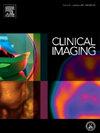Diagnostic value of low-dose CT pulmonary angiography combined with iterative reconstruction in suspected pulmonary embolism
IF 1.5
4区 医学
Q3 RADIOLOGY, NUCLEAR MEDICINE & MEDICAL IMAGING
引用次数: 0
Abstract
Objective
Assessing the utility of low-dose computed tomographic pulmonary angiography (CTPA) employing iterative reconstruction (IR) for the detection of pulmonary embolism (PE), we compared its image quality, and radiation exposure with standard-dose CTPA protocols.
Methods
Patients with suspected PE were prospectively and randomly allocated to either a low-dose CTPA with IR arm (study group, n = 80) or a standard-dose CTPA plus IR arm (control group, n = 80). The low-dose group used 70 kVp and automatic tube current modulation, while the standard-dose group used 120 kVp with conventional parameters. A 5-point scale was used to evaluate subjective image quality. Objective assessment of noise and contrast was performed by quantifying the signal-to-noise ratio (SNR) and contrast-to-noise ratio (CNR) within the pulmonary arteries. Radiation exposure was quantified via computed tomography dose index volume (CTDIvol) and dose-length product (DLP).
Results
Baseline characteristics were comparable between groups (P > 0.05). Subjective image quality was similar, with a non-significant trend towards lower scores in the low-dose group (median 4 [IQR 3–4]) compared to the standard-dose group (P > 0.05). Objective measures showed a non-significant 4.0 % and 5.5 % reduction in SNR and CNR, respectively, in the low-dose group (P > 0.05). Noise levels (SD) were comparable. The low-dose group demonstrated notable reduced radiation exposure: CTDIvol (P < 0.001), DLP (P < 0.001), and effective dose (P < 0.001).
Conclusion
Low-dose CTPA employing IR presents a viable option for PE diagnosis, providing similar diagnostic quality with significantly reduced radiation exposure.
低剂量CT肺血管造影联合迭代重建对疑似肺栓塞的诊断价值
目的评估采用迭代重建(IR)的低剂量计算机断层肺血管造影(CTPA)检测肺栓塞(PE)的效用,并将其图像质量和辐射暴露与标准剂量CTPA方案进行比较。方法将疑似PE患者前瞻性随机分配至低剂量CTPA + IR组(研究组,n = 80)或标准剂量CTPA + IR组(对照组,n = 80)。低剂量组采用70kvp和自动管电流调制,标准剂量组采用120kvp和常规参数。采用5分制评价主观图像质量。通过量化肺动脉内的信噪比(SNR)和对比噪声比(CNR),对噪声和对比度进行客观评估。通过计算机断层扫描剂量指数体积(CTDIvol)和剂量长度积(DLP)对辐射暴露进行量化。结果两组间基线特征具有可比性(P >;0.05)。主观图像质量相似,与标准剂量组相比,低剂量组(中位数4 [IQR 3-4])得分较低(P >;0.05)。客观测量显示,低剂量组的信噪比和CNR分别降低了4.0%和5.5% (P >;0.05)。噪声水平(SD)具有可比性。低剂量组的辐射暴露明显减少:CTDIvol (P <;0.001), DLP (P <;0.001),有效剂量(P <;0.001)。结论低剂量CTPA采用IR诊断PE是可行的选择,在显著降低辐射暴露的情况下,诊断质量相近。
本文章由计算机程序翻译,如有差异,请以英文原文为准。
求助全文
约1分钟内获得全文
求助全文
来源期刊

Clinical Imaging
医学-核医学
CiteScore
4.60
自引率
0.00%
发文量
265
审稿时长
35 days
期刊介绍:
The mission of Clinical Imaging is to publish, in a timely manner, the very best radiology research from the United States and around the world with special attention to the impact of medical imaging on patient care. The journal''s publications cover all imaging modalities, radiology issues related to patients, policy and practice improvements, and clinically-oriented imaging physics and informatics. The journal is a valuable resource for practicing radiologists, radiologists-in-training and other clinicians with an interest in imaging. Papers are carefully peer-reviewed and selected by our experienced subject editors who are leading experts spanning the range of imaging sub-specialties, which include:
-Body Imaging-
Breast Imaging-
Cardiothoracic Imaging-
Imaging Physics and Informatics-
Molecular Imaging and Nuclear Medicine-
Musculoskeletal and Emergency Imaging-
Neuroradiology-
Practice, Policy & Education-
Pediatric Imaging-
Vascular and Interventional Radiology
 求助内容:
求助内容: 应助结果提醒方式:
应助结果提醒方式:


